Seismic Microzonation Map for a Fixed-Jacket Platform in the Malay Basin
Abstract
1. Introduction
2. Materials and Methods
2.1. Phase One: Development of Seismic Microzonation Map
2.1.1. Time Histories
2.1.2. Soil Data
2.1.3. Peak Ground Acceleration (PGa)
2.1.4. Ground Response Analysis (GRa)
2.1.5. Plotting Seismic Microzonation Map
2.2. Phase Two: Development of Map for Soil Amplification Factor
2.3. Phase Three: Determination of Site Coefficients and Design Horizontal Response Spectra
- is the natural period;
- are the site coefficients;
- is the site spectral acceleration corresponding to period ;
- is the site spectral acceleration corresponding to period 0.2 s;
- is the site spectral acceleration corresponding to period 1.0 s.
3. Results and Discussion
3.1. Development of Seismic Microzonation Map
3.1.1. Determination of Peak Surface Acceleration
3.1.2. Plotting Seismic Microzonation Map
3.2. Development of Map for Soil Amplification Factor
3.2.1. Determination of Soil Amplification Factor
3.2.2. Plotting Map of Soil Amplification Factor
3.3. Determination of Design Horizontal Response Spectra and Site Coefficient
3.3.1. Design Horizontal Response Spectra
3.3.2. Site Coefficients for Acceleration and Velocity (Ca and Cv)
4. Conclusions
- The primary objective was achieved. The soil characteristics based on the study area were analyzed for the Malay Basin, which consisted of soil types D and E. Softer soil possesses the highest value of vibration predicted on the seabed (PSa).
- Objective two was achieved. The soil characteristics based on these data were analyzed. It was confirmed that most of the soil were soil types D and E, which were softer soil types; these soil types usually give the basin effect, which is an amplification. The soil amplification factors were successfully developed and could be used in the development and maintenance of offshore facilities in the Malay Basin.
- Objective three was achieved. For the design practices and analysis, response spectra are important, and this study developed ‘designed’ horizontal response spectra for the 5% damping ratio because most of the shallow water structures, such as fixed-jacket platforms, fall in this damping ratio.
Author Contributions
Funding
Institutional Review Board Statement
Informed Consent Statement
Conflicts of Interest
References and Note
- Che Abas, M.R. Earthquake Monitoring in Malaysia. Presented in Seismic Risk Seminar Malaysia on 25 September 2001.
- Adnan, A.; Djazilus, H.; Marto, A.; Irsyam, M. Seismic Hazard Assessment for Peninsular. J. Teknol. 2005, 42, 57–73. [Google Scholar]
- Ghani, K.D.A.; Hamid, N.H.A.; Jaafar, M.S. Load versus Displacement Validation between Ruaumoko Hysteresis Program and Experimental Work on CFRP Retrofitted Precast Beam-Column Exterior Joint. Key Eng. Mater. 2014, 594–595, 390–394. [Google Scholar] [CrossRef]
- Sykes, L.R. Decadal Seismicity Prior to Great Earthquakes at Subduction Zones: Roles of Major Asperities and Low-Coupling Zones. Int. J. Geosci. 2021, 12, 845–926. [Google Scholar] [CrossRef]
- Sadeghi, K. An Overview of Design, Analysis, Construction and Installation of Offshore Petroleum Platforms Suitable for Cyprus Oil/Gas Fields. J. Soc. Appl. Sci. 2007, 2, 1–16. [Google Scholar]
- Bishop, M.G. Petroleum Systems of the Malay Basin Province; US Department of the Interior: Washington, DC, USA, 2002.
- Madon, M.; Yang, J.-S.; Abolins, P.; Hassan, R.A.; Yakzan, A.M.; Zainal, S.B. Petroleum systems of the Northern Malay Basin. Bull. Geol. Soc. Malays. 2006, 49, 125–134. [Google Scholar] [CrossRef]
- Ramli, N. The history of offshore hydrocarbon exploration in Malaysia. Energy 1985, 10, 457–473. [Google Scholar] [CrossRef]
- Sulaiman, N.; Amiruddin, M.A.S.M.; Sulaiman, N.; Khan, M.M.A.; Rosmadi, N.S. Seismic Facies and Geological Structure Interpretation of the A-Field, Malay Basin, Malaysia. IOP Conf. Ser. Earth Environ. Sci. 2020, 549, 012019. [Google Scholar] [CrossRef]
- Hassaan, M.; Bhattacharya, S.K.; Mathew, M.J.; Siddiqui, N.A. Understanding Basin Evolution through Sediment Accumulation Modeling: A Case Study from Malay Basin. Res. J. Appl. Sci. Eng. Technol. 2015, 11, 388–395. [Google Scholar] [CrossRef]
- Kong, L.K. Structural analysis of the Malay Basin. Bull. Geol. Soc. Malays. 1997, 40, 157–176. [Google Scholar] [CrossRef]
- Tjia, H. Growing Evidence of Active Deformation in the Malay Basin Region. Bull. Geol. Soc. Malays. 2010, 56, 35–40. [Google Scholar] [CrossRef]
- Kurian, V.; Wahab, M.; Voon, M.; Liew, M. Pushover Analysis for Jacket Platform Sensitivity Study and Safety Ratios. Available online: http://eprints.utp.edu.my/11318/ (accessed on 6 January 2015).
- Soom, E.M.; Husain, M.K.A.; Zaki, N.I.M.; Nor, M.N.K.M.; Ayob, M.S.; Najafian, G. Global ultimate strength assessment (GUSA) for lifetime extension of ageing offshore structures. Proc. Int. Offshore Polar Eng. Conf. 2015, 2015, 431–435. [Google Scholar]
- Soom, E.M.; Husain, M.K.A.; Zaki, N.I.M.; Nor, M.N.K.M.; Najafian, G. Prediction of Ultimate Shear Strength of Reinforced-Concrete Deep Beams P REDICTION OF U LTIMATE S HEAR S TRENGTH OF R EINFORCED. Malays. J. Civ. Eng. 2018, 30, 152–171. [Google Scholar] [CrossRef]
- Mihalic, S.; Ostric, M.; Krkac, M. Seismic microzonation: A review of principles and practice. GEOFIZIKA 2011, 28, 5–20. [Google Scholar]
- Govindaraju, L.; Ramana, G.V.; Hanumantharao, C.; Sitharam, T.G. Site-specific Ground Response Analysis. Spec. Ed. Geotech. Earthq. Hazards 2004, 87, 1354–1362. [Google Scholar]
- Beyhan, G.; Keskinsezer, A.; Beyhan, S. A Comparative Study on Soil Properties and Applications Review with EERA and NERA in İstanbul-MARMARAY Project between Kazlıçeşme to Sirkeci. Period. Eng. Nat. Sci. 2017, 5, 65–80. [Google Scholar] [CrossRef][Green Version]
- Basu, D.; Dey, A. Comparative 1D Ground Response Analysis of Homogeneous Sandy Stratum Using Linear, Equivalent Linear and Nonlinear Masing Approaches. In Proceedings of the National Seminar on Geotechnics for Infrastructure Development, Kolkata, West Bengal, India, 11–12 March 2016. [Google Scholar]
- Marto, A.; Adnan, A.; Hendriyawan, H.; Irsyam, M. Microzonation Maps for Kuala Lumpur and Putrajaya. Malays. J. Civ. Eng. 2011, 23, 63–85. [Google Scholar]
- Adnan, A.; Hendriyawan; Marto, A. Development of Microzonation Maps of Kuala Lumpur City Centre for Seismic Design of Buildings; The Institution of Engineers: Selangor, Malaysia, 2008; pp. 12–15. [Google Scholar]
- Irsyam, M.; Dangkua, D.T.; Hoedajanto, D. Proposed seismic hazard maps of Sumatra and Java islands and microzonation study of Jakarta city, Indonesia. J. Earth Syst. Sci. 2008, 117, 865–878. [Google Scholar] [CrossRef]
- First, S.; Isik, N.S.; Arman, H.; Demir, M.; Vural, I. Investigation of the Soil Amplification Factor in the Adapazari Region. Bull. Eng. Geol. Environ. 2015, 75, 141–152. [Google Scholar] [CrossRef]
- Kramer, S.L. Geotechnical Earthquake Engineering; Prentice Hall: Hoboken, NJ, USA, 1996. [Google Scholar]
- Adrian, R.-M.; Jonathan, D.B.; Norman, A.A. A Geotechnical Seismic Site Response Evaluation Procedure. In Proceedings of the Twelfth World Conference on Earthquake Engineering, Auckland, New Zealand, 30 January–4 February 2000; Volume 14, p. 1590. Available online: http://www.iitk.ac.in/nicee/wcee/article/1590.pdf (accessed on 8 November 2017).
- ISO 19901-2; Petroleum and Natural Gas Industries—Specific Requirements for Offshore Structures—Part 2: Seismic Design Procedures and Criteria. American National Standards Institute: New York, NY, USA, 2004.
- Freeman, S.A. Response Spectra as a Useful Design and Analysis Tool for Practicing Structural Engineers. ISET J. Earthq. Technol. 2007, 44, 25–37. [Google Scholar]
- Chang, B.; Abraham, M.; Peng, B.; Engineering, J.R.M. Comparison of ISO and API Seismic Design Guidelines Using Three Existing Offshore Platforms. In Proceedings of the Offshore Technology Conference, Houston, TX, USA, 2–5 May 2005. [Google Scholar] [CrossRef]
- Villaverde, R. Fundamental Concepts of Earthquake Engineering, 1st ed.; CRC Press—Taylor & Francis Group: Boca Raton, FL, USA, 2009. [Google Scholar]
- Hegazy, Y.A.; Mayne, P.W. Statistical Correlations Between Vs and CPT Data for Different Soil Types. In Proceedings of the International Symposium on Cone Penetration Testing: CPT’95, Linkoping, Sweden, 4–5 October 1995; Volume 2, pp. 173–178. [Google Scholar]
- Mayne, P.W. In-situ test calibrations for evaluating soil parameters. In Proceedings of the Characterization and Engineering Properties of Natural Soils II, Singapore, 29 November–1 December 2006; pp. 1601–1652. [Google Scholar]
- Sykora, D.W. Examination of Existing Shear Wave Velocity and Shear Modulus Correlations in Soils, Vicksburg, Mississippi, 1987. Available online: www.dtic.mil/get-tr-doc/pdf?AD=ADA214721 (accessed on 17 November 2017).
- Hoe, L.Y. Soil Amplification Factor of Seismic Ground Motions in Laho (PMO), Kumang (SKO) and Sumandak (SBO) in Malaysian Offshore; IRC, Universiti Teknologi PETRONAS: Perak, Malaysia, 2015. [Google Scholar]
- Organisation of Educational Cooperation. Seismic Hazard study and Zoning of Offshore Location in Malaysia: Peninsular Malaysia, Sarawak and Sabah Operations; Organisation of Educational Cooperation: Perak, Malaysia, 2014. [Google Scholar]
- Bardet, J.P.; Tobita, T. NERA A Computer Program for Nonlinear E arthquake site R Esponse A Nalyses of Layered Soil Deposits. Department of Civil Engineering, University of Southern California. 2001. Available online: https://sites.google.com/site/tt60898/home/software (accessed on 28 April 2016).
- Lam, N.; Tsang, H.H.; Looi, D.; Lumantara, E.; Wilson, J. Seismic Hazard Modelling for Malaysia and Singapore. In Proceedings of the 2017 World Congress on Advances in Structural Engineering and Mechanics (ASEM17), Ilsan, Korea, 28 August–1 September 2017. [Google Scholar]
- Nabilah, A.B.; Koh, C.G.; Safiee, N.A.; Daud, N.N.N. Site Specific Seismic Hazard Assessment for Kuala Lumpur And Vicinity from Long Distance Earthquakes, no. Special Publication for NCWE2017; Faculty of Civil Engineering & Earth Resources, University Malaysia Pahang (UMP): Pekan, Malaysia, 2017; pp. 15–20. [Google Scholar]
- Loi, D.W.; Raghunandan, M.E.; Swamy, V. Revisiting seismic hazard assessment for Peninsular Malaysia using deterministic and probabilistic approaches. Nat. Hazards Earth Syst. Sci. 2018, 18, 2387–2408. [Google Scholar] [CrossRef]
- Carlton, B.; Barwise, A.; Kaynia, A.M. Seismic Hazard Assessment for a Wind Farm Offshore England. Geotechnics 2022, 2, 14–31. [Google Scholar] [CrossRef]
- Birkmann, J. Measuring Vulnerability to Natural Hazards; United Nations University Press: Tokyo, Japan, 2013. [Google Scholar]
- Thitimakorn, T.; Raenak, T. NEHRP Site Classification and Preliminary Soil Amplification Maps of Lamphun City, Northern Thailand. Open Geosci. 2016, 8, 538–547. [Google Scholar] [CrossRef]
- Yunita, H.; Setiawan, B.; Saidi, T.; Abdullah, N. Site response analysis for estimating seismic site amplification in the case of Banda Aceh—Indonesia. In Proceedings of the AASEC 2018 The 3rd Annual Applied Science and Engineering Conference, Bandung, Indonesia, 18 April 2018; Volume 10002, pp. 1–6. [Google Scholar]
- Majid, T.A.; Zaini, S.S.; Nazri, F.M.; Arshad, M.R.; Suhaimi, I.F.M. Development of Design Response Spectra for Northern Peninsular Malaysia Based on UBC 97 Code. Inst. Eng. Malays. 2007, 68, 23–29. [Google Scholar]
- Asakereh, A.; Jamali, H.; Naderi, E. The Influence of Seismic Parameters on Site Response. Civ. Eng. Dimens. 2015, 17, 76–87. [Google Scholar] [CrossRef]
- Yunita, H.; Djazilus, H.; Apriadi, D. An Overview of Soil Models for Earthquake Response Analysis. J. Eng. Technol. Sci. 2015, 47, 57–75. Available online: http://journals.itb.ac.id/index.php/jets/article/view/362/782 (accessed on 25 July 2021). [CrossRef]
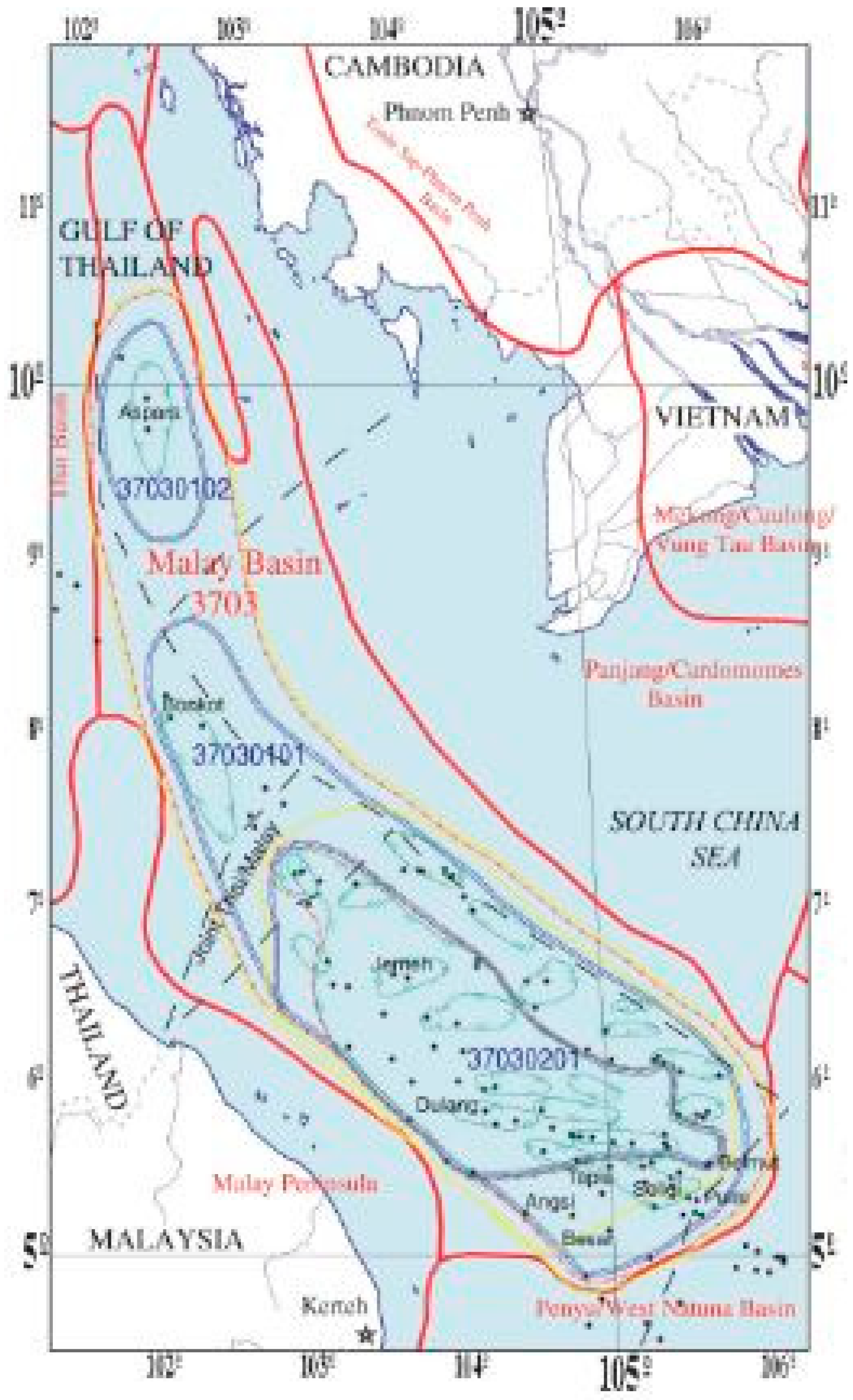
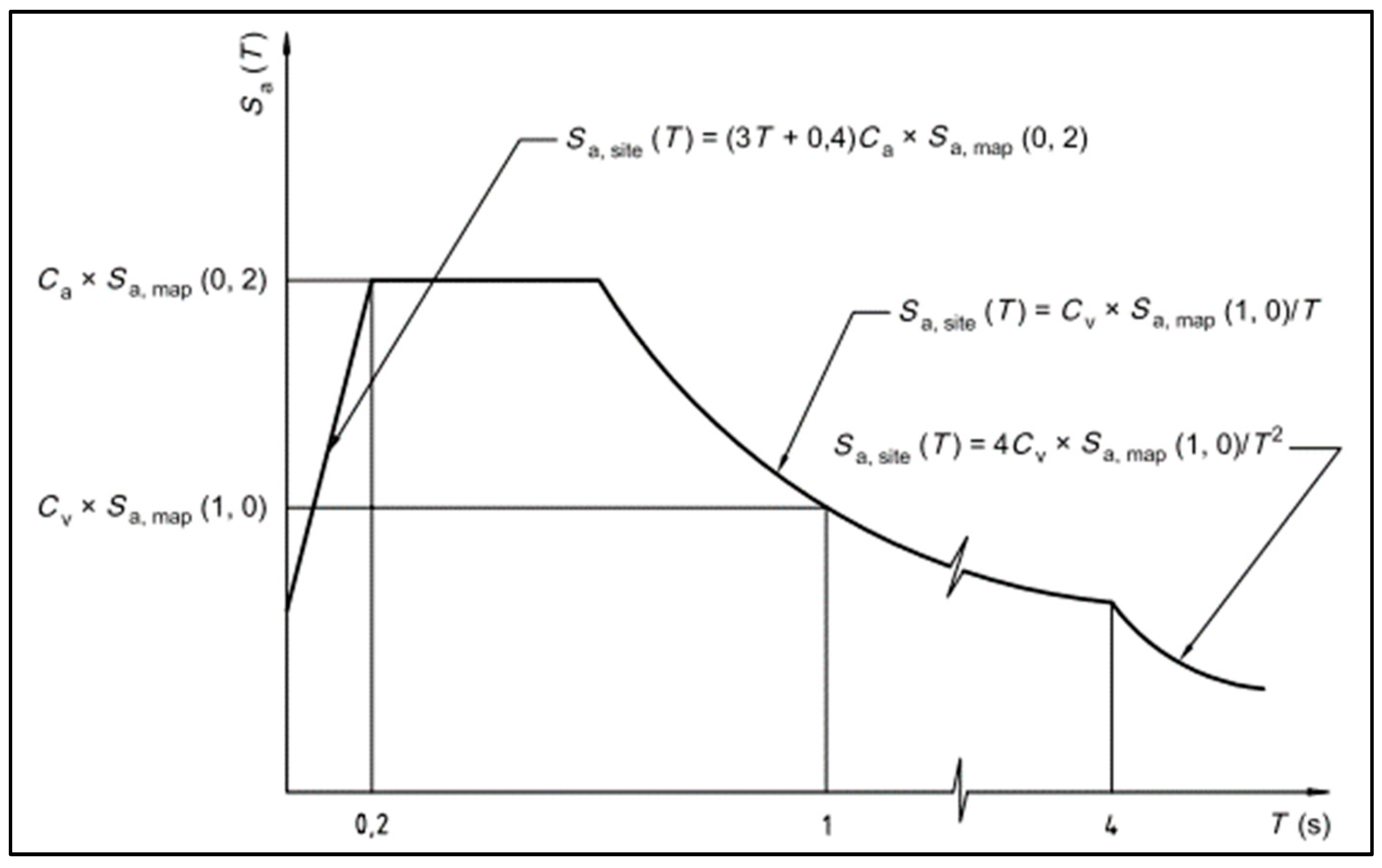
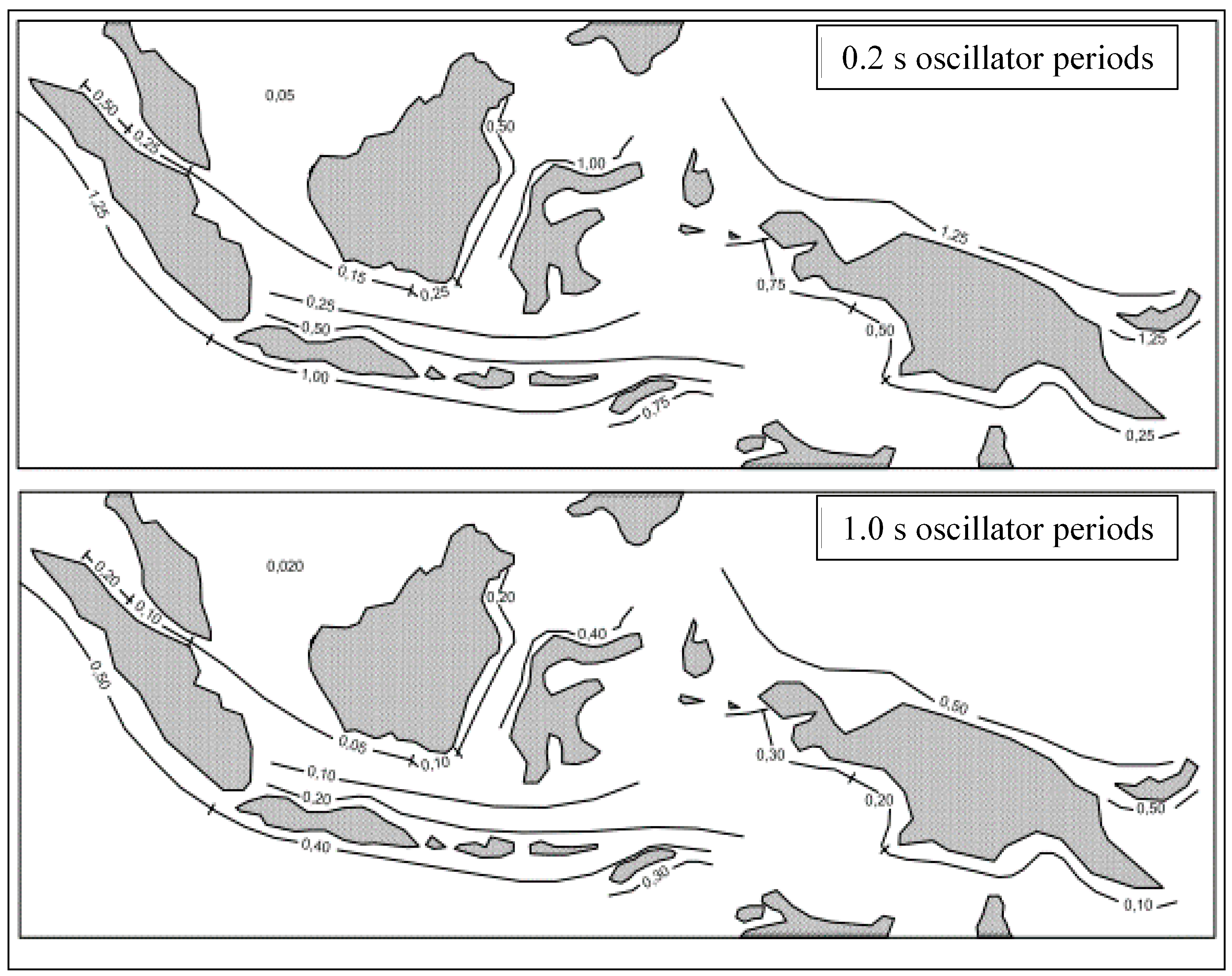
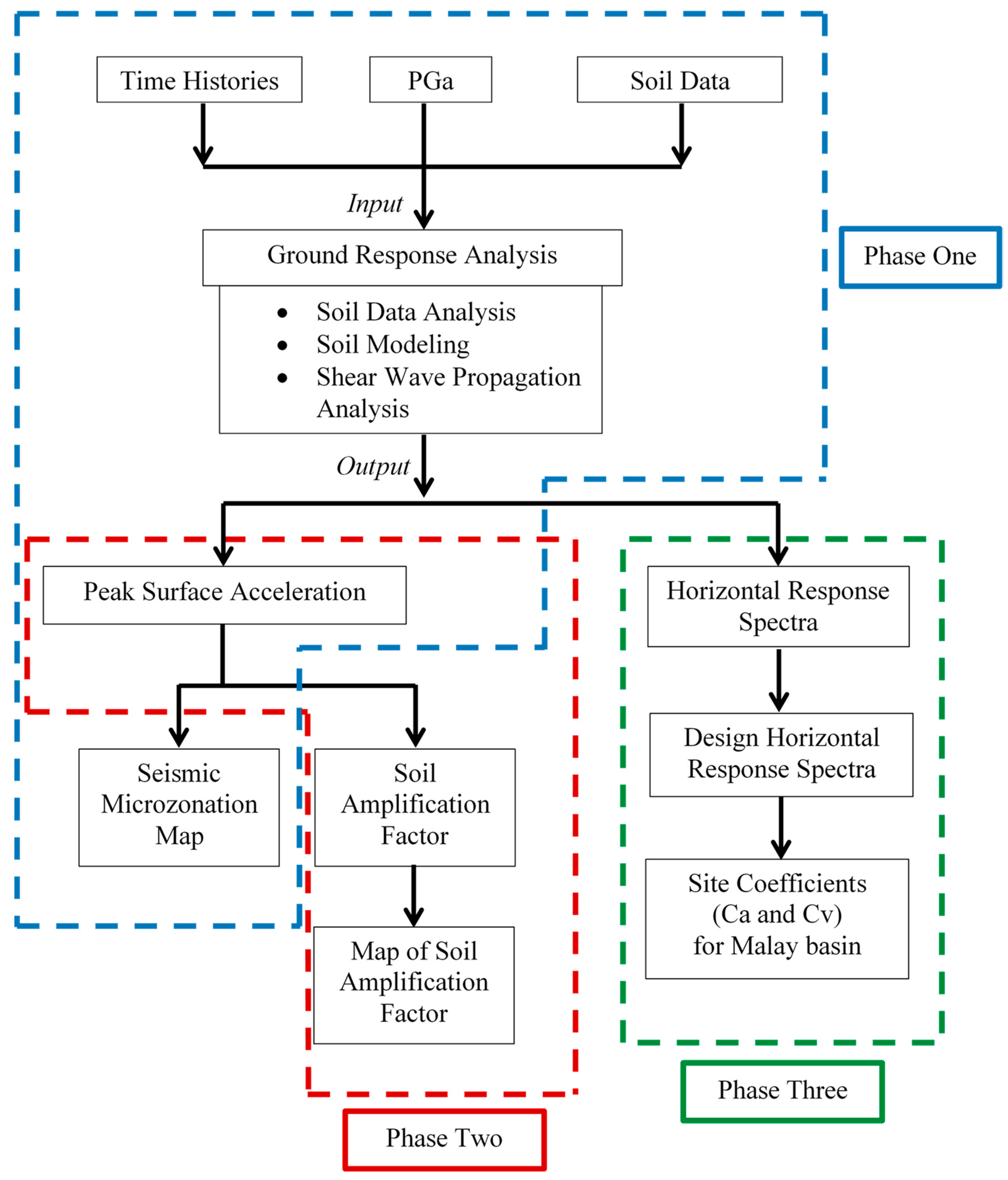
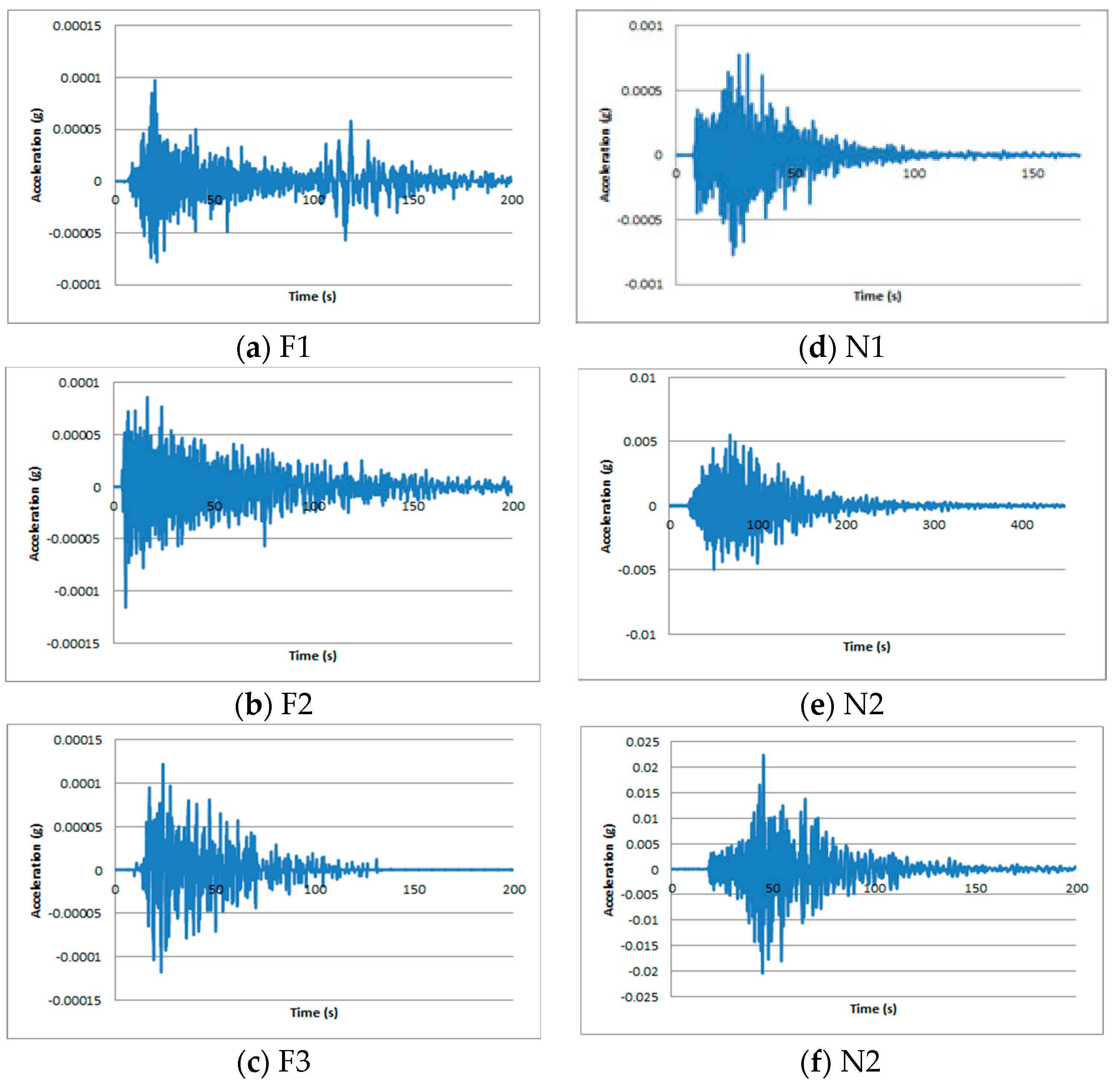
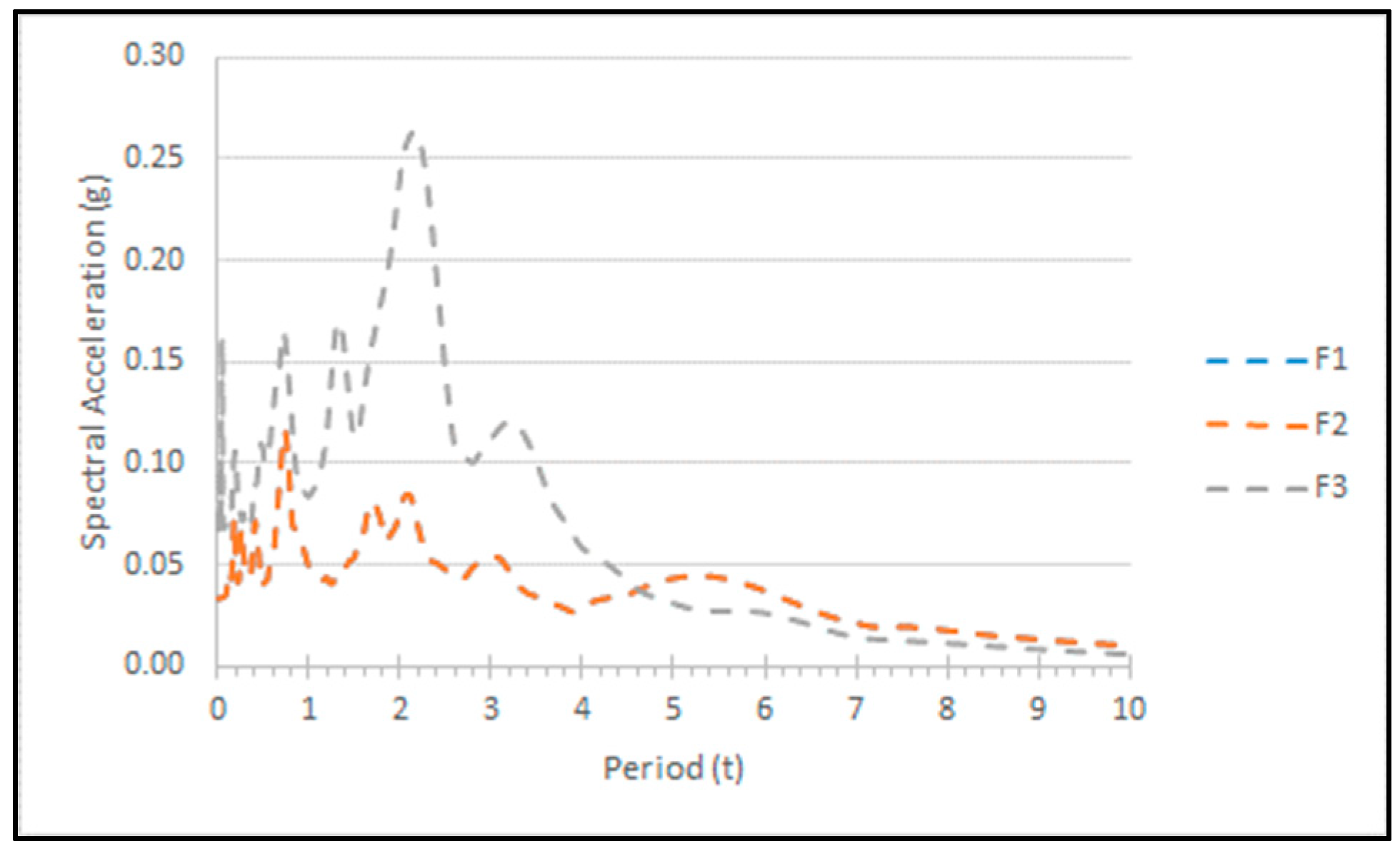

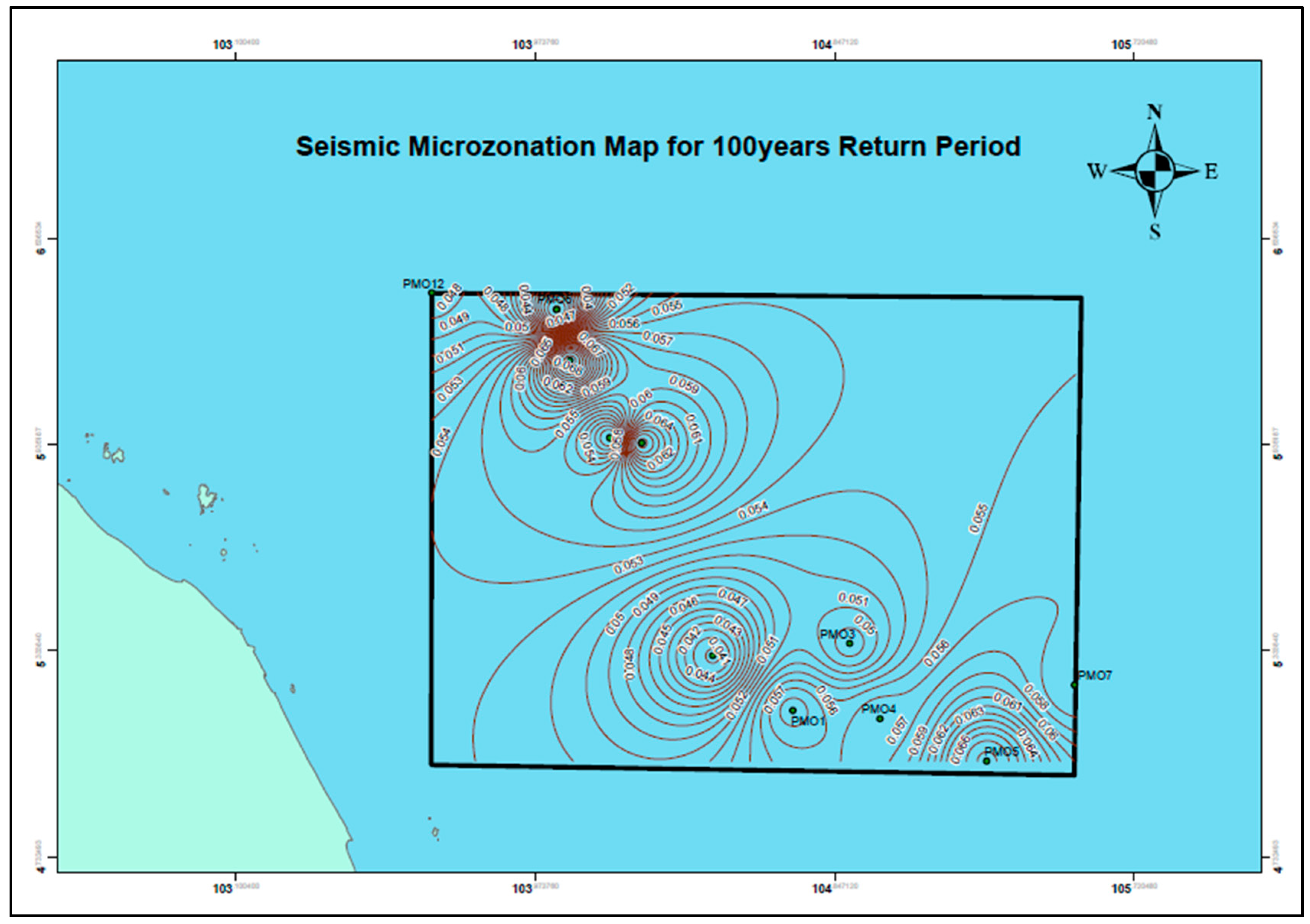
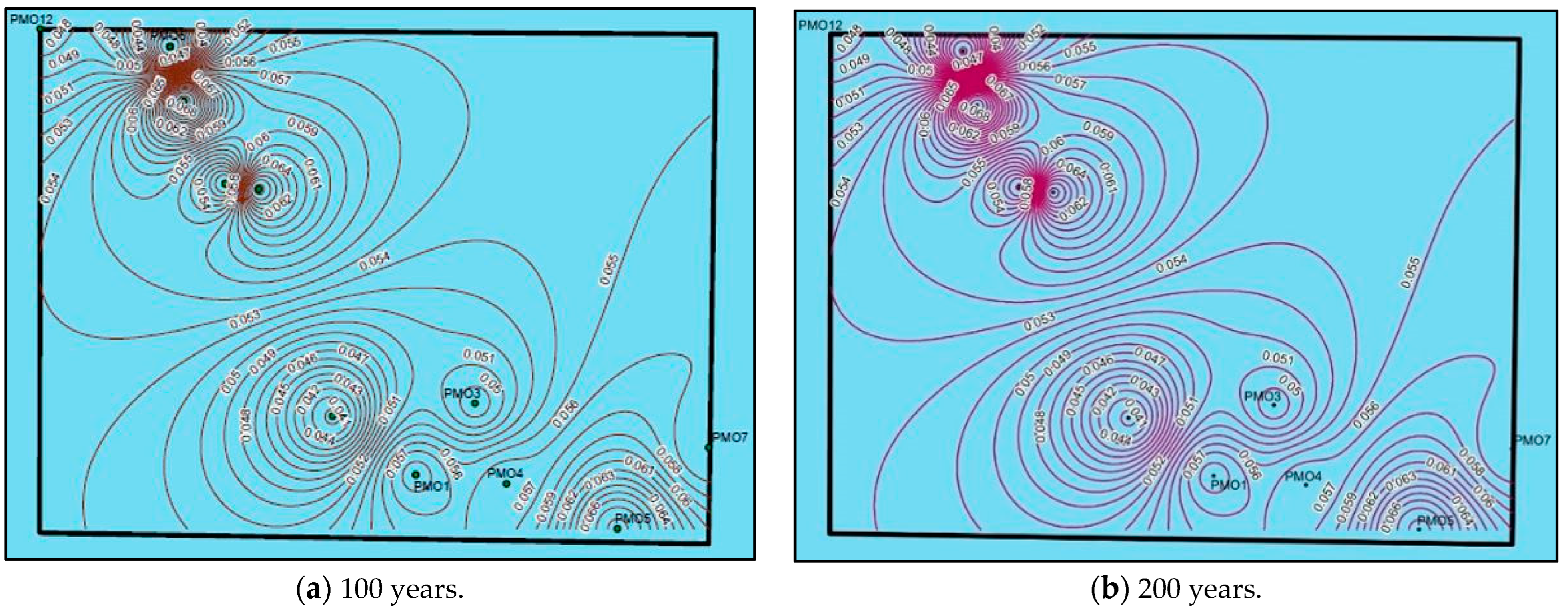
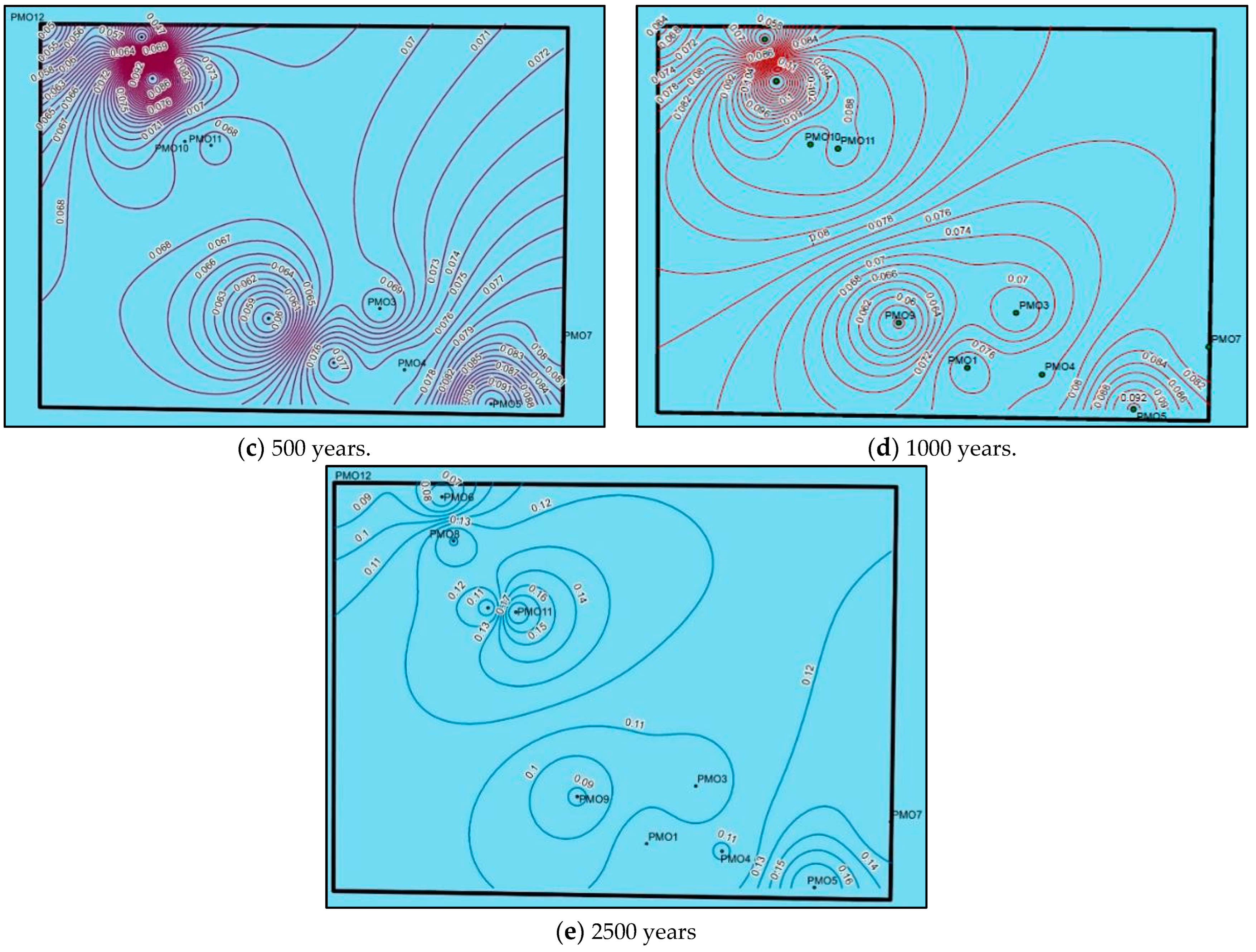

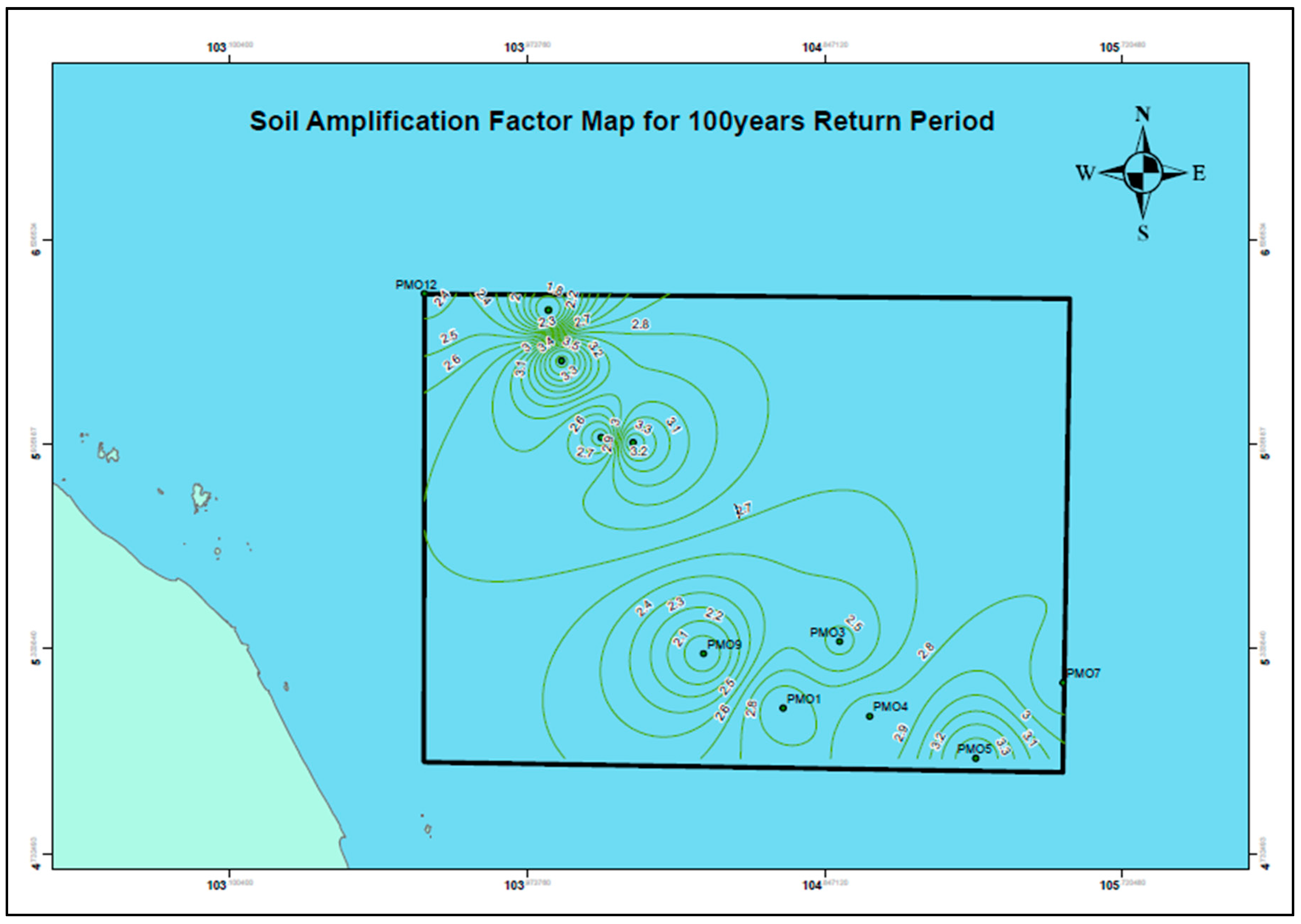
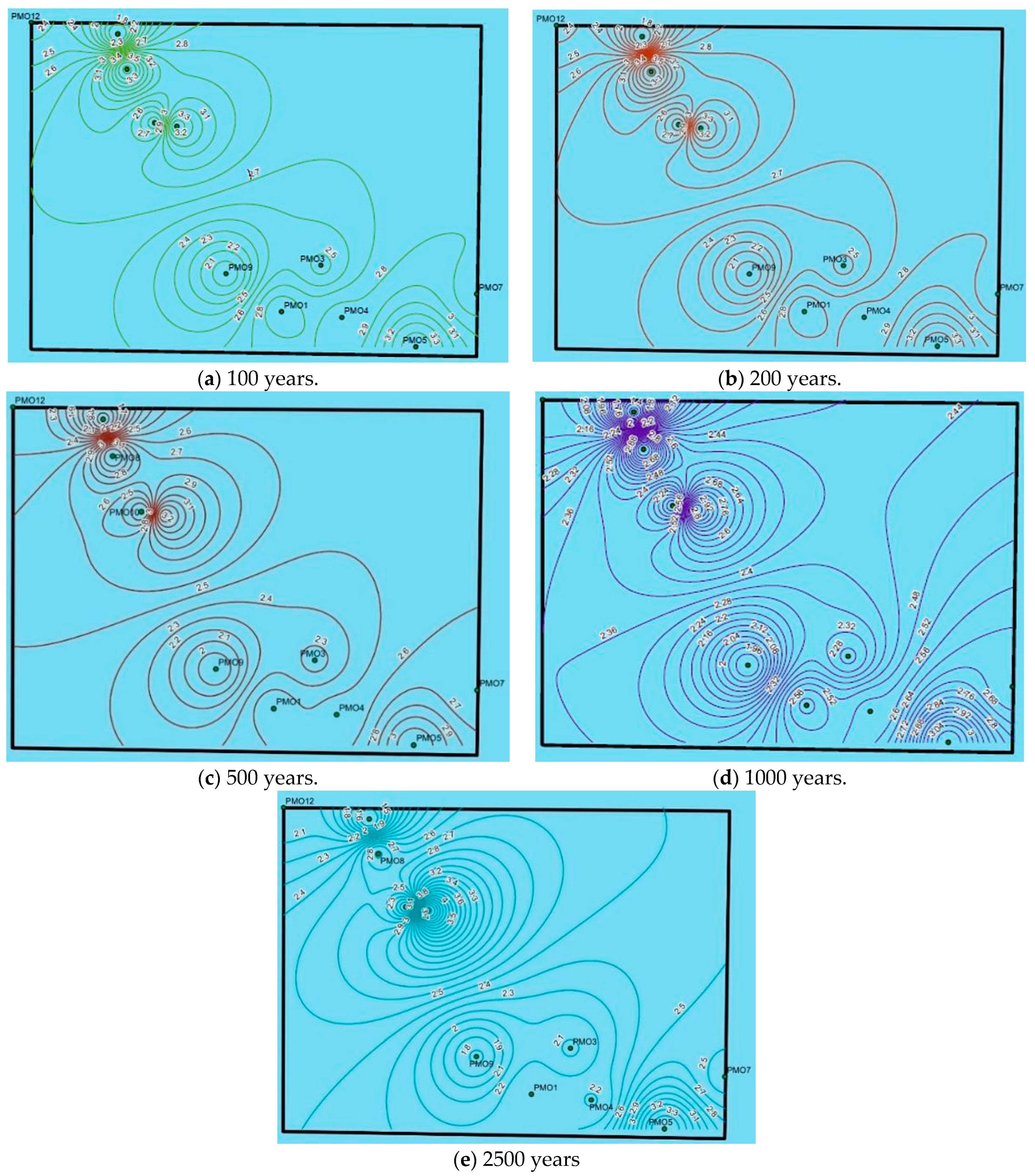
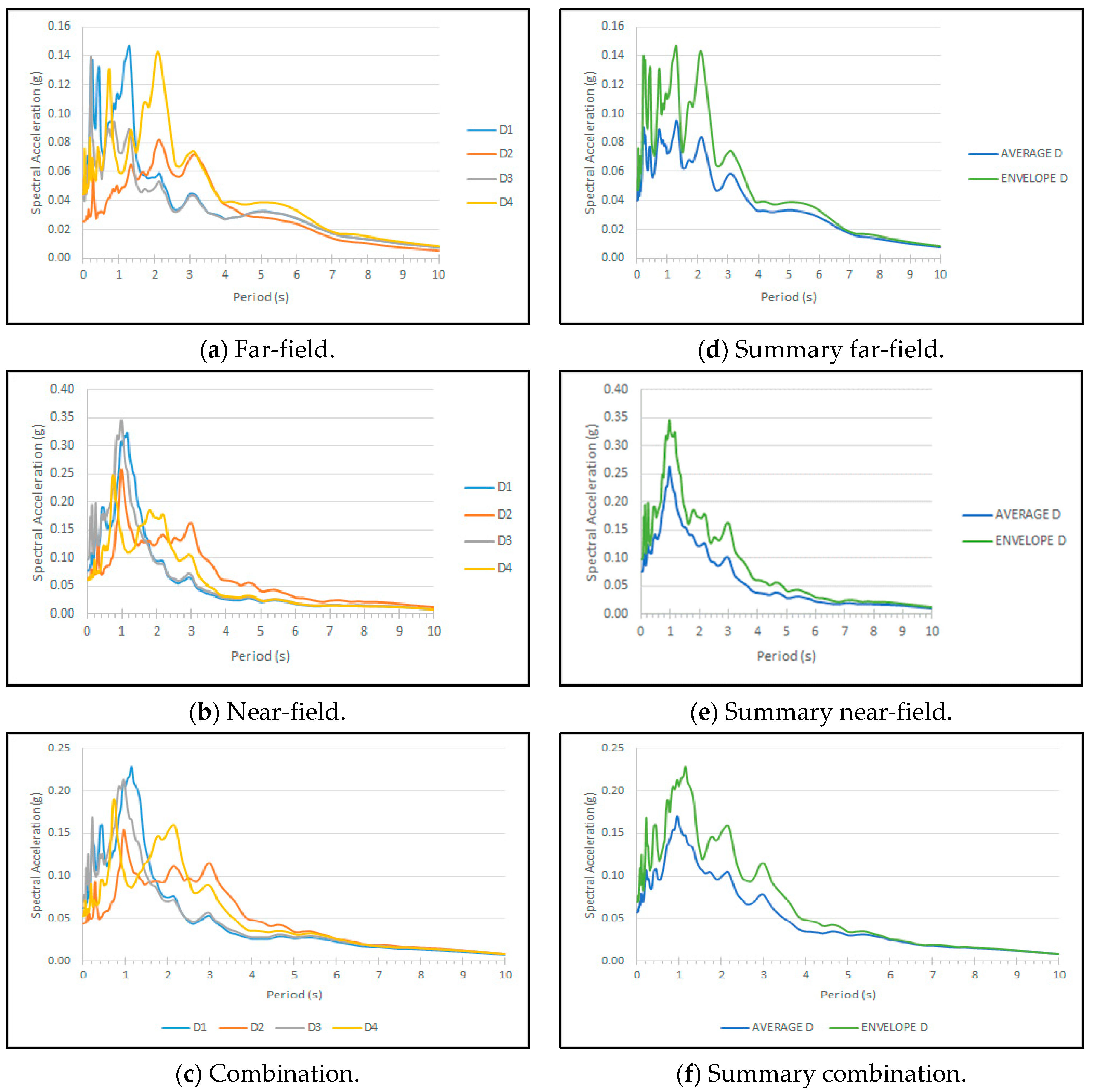
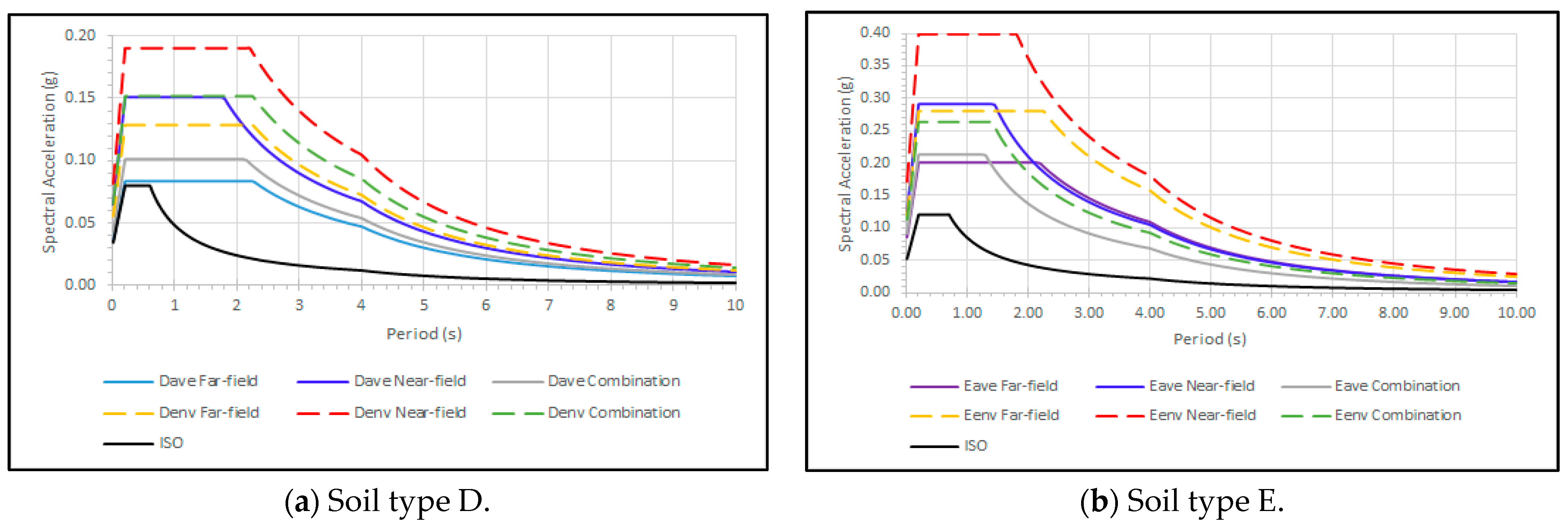
| Soil Type | Model | Equation for Vs | r2 | Paired Data |
|---|---|---|---|---|
| All Soil | Hegazy and Mayne (1995) | (101 log(qc) − 11.4)1.47 (100 fs/qc)0.3 | 0.70 | 323 |
| Mayne (2007) | 118.8 log(fs) + 18.5 | 0.82 | 161 | |
| Sand | Sykora and Stokoe (1983) | 134.1 + 0.0052 qc | 0.61 | 256 |
| Hegazy and Mayne (1995) | 12.02 qc0.319 fs−0.0466 | 0.57 | 92 | |
| Clay | Hegazy and Mayne (1995) | 3.18 qc0.549 fs0.025 | 0.78 | 229 |
| Mayne and Rix (1995) | 1.75 qc0.627 | 0.74 | 481 |
| Depth (m) | Thickness | Soil | Vs | |
|---|---|---|---|---|
| From | To | (m) | Description | (m/s) |
| 0.0 | 6.9 | 6.9 | Very soft to soft clay | 117.764 |
| 6.9 | 9.8 | 2.9 | Stiff silt | 193.169 |
| 9.8 | 14.9 | 5.1 | Stiff clay | 162.077 |
| 14.9 | 21.6 | 6.7 | Firm to stiff clay | 150.722 |
| 21.6 | 24.0 | 2.4 | Very stiff silt | 282.296 |
| 24.0 | 27.2 | 3.2 | Firm clay | 208.693 |
| 27.2 | 29.8 | 2.6 | Very stiff silt | 231.147 |
| 29.8 | 38.9 | 9.1 | Stiff clay | 200.705 |
| 38.9 | 44.8 | 5.9 | Stiff to very stiff clay | 204.381 |
| 44.8 | 50.0 | 5.2 | Very stiff silt | 280.731 |
| Coordinate | PGa (g) | |||||
|---|---|---|---|---|---|---|
| Lat. | Long. | 100-Year Return Period | 200-Year Return Period | 500-Year Return Period | 1000-Year Return Period | 2500-Year Return Period |
| 3.0 | 103.5 | 0.02 | 0.03 | 0.04 | 0.05 | 0.07 |
| 3.5 | 103.5 | 0.02 | 0.03 | 0.03 | 0.05 | 0.07 |
| 4.0 | 103.5 | 0.02 | 0.02 | 0.03 | 0.04 | 0.06 |
| 4.5 | 103.5 | 0.02 | 0.02 | 0.03 | 0.04 | 0.05 |
| 5.0 | 103.5 | 0.02 | 0.02 | 0.03 | 0.03 | 0.05 |
| 5.5 | 103.5 | 0.02 | 0.02 | 0.02 | 0.03 | 0.04 |
| Fundamental Period (s) = 1.04 | |||||||||
|---|---|---|---|---|---|---|---|---|---|
| Average Shear Wave Velocity (m/sec) = 192.95 | |||||||||
| Total Number of Sublayers = 11 | |||||||||
| Layer Number | Soil Material Type | Thickness of Layer (m) | Maximum Shear Modulus Gmax (MPa) | Total Unit Weight (kN/m3) | Shear Wave Velocity (m/sec) | Location of Water Table | Depth at Top of Layer (m) | Vertical Effective Stress (kPa) | |
| Surface | 1 | 1 | 6.9 | 25.49 | 18.03 | 117.764 | 0.0 | 0.00 | |
| 2 | 1 | 2.9 | 68.58 | 18.03 | 193.169 | 6.9 | 124.41 | ||
| 3 | 1 | 5.1 | 48.28 | 18.03 | 162.077 | 9.8 | 176.69 | ||
| 4 | 1 | 6.7 | 41.75 | 18.03 | 150.722 | 14.9 | 268.65 | ||
| 5 | 1 | 2.4 | 168.40 | 20.73 | 282.296 | 21.6 | 389.45 | ||
| 6 | 1 | 3.2 | 85.82 | 19.33 | 208.693 | 24.0 | 439.20 | ||
| 7 | 1 | 2.6 | 105.28 | 19.33 | 231.147 | 27.2 | 501.06 | ||
| 8 | 1 | 9.1 | 79.37 | 19.33 | 200.705 | 29.8 | 551.31 | ||
| 9 | 1 | 5.9 | 76.77 | 18.03 | 204.381 | 38.9 | 727.22 | ||
| 10 | 1 | 5.2 | 155.29 | 19.33 | 280.731 | 44.8 | 833.59 | ||
| Bedrock | 11 | 0 | 3333.52 | 22.00 | 1219.2 | 50.0 | 934.11 | ||
| Type of | Site Coefficient | ||||
|---|---|---|---|---|---|
| Seismic Events | DHRSa | Soil Type | Ca | Cv | |
| PROPOSED | Far-field | Average | D | 1.5 | 3.7 |
| Envelope | 2.5 | 6.0 | |||
| Average | E | 3.6 | 9.2 | ||
| Envelope | 4.5 | 11.8 | |||
| Near-field | Average | D | 2.7 | 5.4 | |
| Envelope | 3.4 | 8.4 | |||
| Average | E | 5.2 | 8.4 | ||
| Envelope | 7.1 | 14.4 | |||
| Combination of | Average | D | 1.8 | 4.3 | |
| far-field and | Envelope | 2.7 | 6.8 | ||
| near-field | Average | E | 3.6 | 5.4 | |
| Envelope | 4.5 | 7.0 | |||
| ISO | NA | NA | D | 1.6 | 2.4 |
| NA | E | 2.4 | 4.2 | ||
Publisher’s Note: MDPI stays neutral with regard to jurisdictional claims in published maps and institutional affiliations. |
© 2022 by the authors. Licensee MDPI, Basel, Switzerland. This article is an open access article distributed under the terms and conditions of the Creative Commons Attribution (CC BY) license (https://creativecommons.org/licenses/by/4.0/).
Share and Cite
Mazlina, M.; Liew, M.S.; Danyaro, K.U.; Adnan, A.; Hamid, N.H.A. Seismic Microzonation Map for a Fixed-Jacket Platform in the Malay Basin. Appl. Sci. 2022, 12, 9194. https://doi.org/10.3390/app12189194
Mazlina M, Liew MS, Danyaro KU, Adnan A, Hamid NHA. Seismic Microzonation Map for a Fixed-Jacket Platform in the Malay Basin. Applied Sciences. 2022; 12(18):9194. https://doi.org/10.3390/app12189194
Chicago/Turabian StyleMazlina, Mohamad, M. S. Liew, Kamaluddeen Usman Danyaro, Azlan Adnan, and Nor Hayati Ab Hamid. 2022. "Seismic Microzonation Map for a Fixed-Jacket Platform in the Malay Basin" Applied Sciences 12, no. 18: 9194. https://doi.org/10.3390/app12189194
APA StyleMazlina, M., Liew, M. S., Danyaro, K. U., Adnan, A., & Hamid, N. H. A. (2022). Seismic Microzonation Map for a Fixed-Jacket Platform in the Malay Basin. Applied Sciences, 12(18), 9194. https://doi.org/10.3390/app12189194






